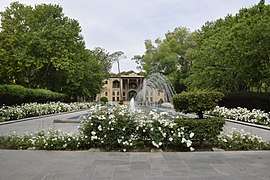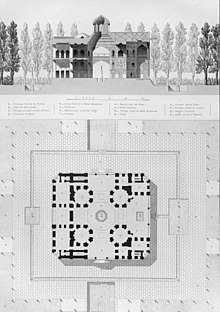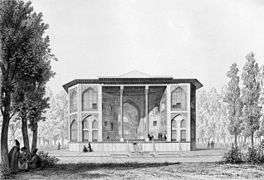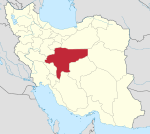Hasht Behesht
Hasht Behesht (هشتبهشت, Hašt-Behešt), literally meaning "the Eight Heavens" in Persian, is a 17th-century pavilion in Isfahan, Iran. It was built by order of Suleiman I, the eighth shah of Iran's Safavid Empire, and functioned mainly as a private pavilion.[1] It is located in Isfahan's famous Charbagh Street.
| Hasht Behesht | |
|---|---|
 | |

| |
| General information | |
| Architectural style | Iranian |
| Location | Isfahan, Iran |
| Coordinates | 32.6534°N 51.6702°E |
Structure

As indicated on its name, the two-story pavilion of Hasht Behesht was built on the hasht-behesht plan, that is a type of floor plan consisting of a central hall surrounded by eight rooms.[2] The building is of an octagonal shape,[2] and has two main entrances. Four larger sides of it feature large balconies (iwans), under which some tall and thin wooden columns are raised.
The pavilion is decorated with mural paintings, perforated woodwork, prismatic mirrors, tilework, and plasterwork.[1][3]
Gallery
 An 1840 drawing of Hasht Behesht by French artist Pascal Coste.
An 1840 drawing of Hasht Behesht by French artist Pascal Coste. Hasht Behesht seen from behind the pool.
Hasht Behesht seen from behind the pool..jpg) A room inside Hasht Behesht.
A room inside Hasht Behesht..jpg) Interior of a ceiling in Hasht Behesht.
Interior of a ceiling in Hasht Behesht. Interior of a ceiling in Hasht Behesht.
Interior of a ceiling in Hasht Behesht..jpg) Interior of a ceiling in Hasht Behesht.
Interior of a ceiling in Hasht Behesht..jpg) Interior of a ceiling in Hasht Behesht.
Interior of a ceiling in Hasht Behesht. An exterior view of Hasht Behesht.
An exterior view of Hasht Behesht. Hasht Behesht at night.
Hasht Behesht at night.
References
- Babaie, Sussan; Haug, Robert (April 5, 2012). "Isfahan x. Monuments (2) Palaces". Encyclopædia Iranica. XIV. pp. 14–20.
- Bernardini, Michele (March 20, 2012). "HAŠT BEHEŠT (2)". Encyclopædia Iranica. XII. pp. 49–51.
- "Hasht Behesht Palace". Lonely Planet. Retrieved 15 October 2018.
Bibliography
- Wilber, D. N. (1962). Persian Gardens and Garden Pavilions. Tokyo. pp. 107–11.
- Ferrante, M. (1968). "Le Pavillon de Hašt Bihišt, ou les Huit Paradis, à Ispahan: Relevés et problèmes s'y rattachant'". In Zander, G. (ed.). Travaux de restauration de monuments historiques en Iran. Rome. pp. 399–420.
| Wikimedia Commons has media related to Hasht behesht palace. |

